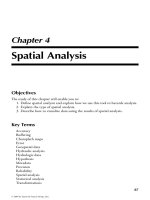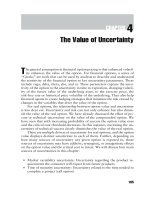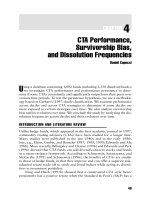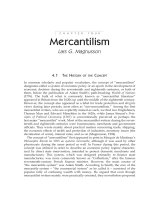BIOLOGICALLY ACTIVE NATURAL PRODUCTS: AGROCHEMICALS - CHAPTER 4 ppsx
Bạn đang xem bản rút gọn của tài liệu. Xem và tải ngay bản đầy đủ của tài liệu tại đây (797.2 KB, 8 trang )
4
Phytochemical Inhibitors from the Nymphaeceae:
Nymphaea odorata and Nuphar lutea
Stella D. Elakovich, Stacy Spence, and Jie Yang
CONTENTS
4.1 Introduction
4.2 Nuphar lutea
4.3 Nymphaea odorata
4.4 Conclusions
Acknowledgments
References
KEY WORDS: Nymphaeceae, Nymphaea odorata, Nuphar lutea, hydrophytes, allelopathy,
growth inhibition, alkaloids, gallotannins.
ABSTRACT From a survey for potential allelopathic activity of some 25 herbaceous
hydrophytes native to the southeastern U.S., we found two species in the Nymphaeceae to
possess the greatest inhibitory activity. Nuphar lutea was the most active species and was
some 10 times more active than Nymphaea odorata, the second most active as measured by
lettuce seedling and Lemna minor growth assays. Bioassay-directed isolation of plant
growth inhibitory constituents from N. odorata led to the isolation of five allelochemicals of
moderate activity. These included gallic acid, myricitrin, myricetin, 1,2,3,4,6-pentagalloyl-
D-glucose, and 2,3,4,6-tetragalloyl-D-glucose. Examination of alkaloids from N. lutea
showed 6,6′-dihydroxythiobinupharidine to be highly inhibitory of lettuce seedling radicle
elongation at concentrations greater than 2 ppm. Nupharolutine, a second alkaloid isolated
that was of similar structure, was inactive. Literature reports of phytochemicals present in
N. odorata and N. lutea, as well as in other members of the Nymphaeceae, are examined.
4.1 Introduction
In our work in the area of allelopathy (the influence of one plant on another), we have been
working with aquatic and wetland plants native to the southeast U.S. We have examined
more than 25 different aqueous extracts from these plants to determine their allelopathic
potential.
1-3
The plant species examined are listed in Table 4.1. Species of Eleocharis were
included as they often appear in monoculture in their undisturbed natural habitats and
© 1999 by CRC Press LLC
have been observed to “displace” other hydrophytes.
4
Some species, including Hydrilla ver-
ticillata and Myriophyllum aquaticum, were chosen because they are among the most nox-
ious of aquatic weeds. Other species were included based on their observed growth
patterns and their propensity toward monocultures, and some species were selected based
on previous reports of allelopathic activity. Aqueous extracts of each of the plants were sub-
jected to lettuce seedling and Lemna minor bioassays. Lettuce seedlings are perhaps the
most widely used plant growth inhibition target system.
1,5,6
We pregerminated the seeds,
ran each assay at three extract concentrations using 20 seedlings per plate, and ran dupli-
cate plates. Radicle lengths were compared to controls.
1
Lemna minor bioassay allows the
use of this small floating aquatic plant, with the common name duckweed, as the target
species for exploration of the allelopathic nature of aquatic hydrophytes.
7
We maintained
axenic L. minor cultures, ran the assay in 24-well sterile tissue culture plates with 1.5 mL of
growth medium per well. We then ran each assay at concentrations corresponding to the
three concentrations of the lettuce seedling assays, ran six replications per 24-well plate,
and ran duplicate plates which agreed to within ± 5%.
1
Control and extract wells were cho-
sen such that position was random, and the assay was read when the control wells reached
20 fronds. Advantages of this assay are that it required only 1.5 mL of growth medium to
accommodate the entire target L. minor plant, and that aquatic plant targets are more
appropriate for evaluation of aquatic plant allelopathy. Results of these initial bioassays
showed species in the Nymphaeceae to possess the highest allelopathic potential. World-
wide members of the Nymphaeaceae are listed in Table 4.2. Some botanists also include the
two genera of Cobombaceae, Brasenia schreberi and Cabomba (about seven species), in the
Nymphaeceae. Of the six genera listed in Table 4.2, we examined only Nuphar and Nym-
phaea, as these were the only plants readily available to us in the southeastern U.S. The oth-
ers are native to Southeast Asia, Australia, or South America. We did, however, also
examine Cabomba caroliniana and Brasenia schreberi, two species sometimes included in the
Nymphaeceae. Table 4.3 gives lettuce seedling bioassay results of only the most inhibitory
TABLE 4.1
Plants Native to the southeastern U.S. Examined for Allelopathic Potential
Brasenia schreberi Gmel. Juncus repens Michx.
Cabomba caroliniana Gray Limnobium spongia (Bosc.) Steud.
Ceratophyllum demersum L. Myriophyllum aquaticum (Vell.) Verdc.
Eleocharis acicularis (L.) R. and S. M. spicatum L.
E. equisetoides (Ell.) Torr. Najas guadalupensis (Spreng.) Maagus
E. flavescens (Poir.) Urban Nuphar lutea (L.) Sibth. and Sm.
E. montana (HBK.) R. and S. Nymphaea odorata Ait.
E. obtusa (Willd.) Shultes Nymphoides cordata Ell.
E. quandrangulata (Michx.) R. and S. Potamogeton foliosus Raf.
E. tuberculosa (Michx.) R. and S. Sparganium americanum Nutt.
Hydrilla verticillata (L.F.) Royal Vallisneria americana Michx.
TABLE 4.2
Worldwide Members of the Genera in the
Nymphaeaceae Family
Barclaya (two species — tropical Southeast Asia)
Euryale ferox (one species — Southeast Asia)
Ondinae purpurea (one species — northwestern Australia)
Nuphar (7 to 20 species — Northern temperate)
Nymphaea (~40 species — cosmopolitan)
Victoria (two species — South America)
© 1999 by CRC Press LLC
extracts tested at 250 ppt. Both N. lutea and N. odorata were divided into above ground and
below ground parts before testing. Table 4.4 gives Lemna minor bioassay results of only the
most inhibitory extracts tested at 250 ppt. Clearly, Nuphar lutea completely inhibits all growth
of both lettuce seedlings and L. minor at this concentration. Brasenia schreberi and Combomba
caroliniana, two of the occasional members of the Nymphaeceae, also are among these most
inhibitory extracts towards lettuce seedling and Lemna minor as target plants, respectively.
Table 4.5 summarizes the results of N. lutea inhibition of lettuce seedlings and L. minor at
much lower concentrations than the 250 ppt of Tables 4.3 and 4.4. N. lutea was significantly
inhibitory even at 2.5 ppt. It was 10 fold more inhibitory in these two bioassays than the
overall next most active plant, Nymphaea odorata.
4.2 Nuphar lutea
The genus Nuphar has been examined rather extensively and others have reported anti-
fungal activity
8
and the medical utility
9
of Nuphar extracts. The genus is such a rich source
of alkaloids that these are known as Nuphar alkaloids.
10
N. lutea produces alkaloids having
a regular sesquiterpenic skeleton incorporated into 3-furyl-substituted piperidines or quin-
olizidines, as well as C30 alkaloids that contain a sulfur atom along with two 3-furyl sub-
stituents.
11-13
As none of these alkaloids had previously been examined for allelopathic
TABLE 4.3
Bioassay Results of Inhibition of Lettuce Radicles
by Aqueous Extracts of Selected Hydrophytes
Nuphar lutea (roots and rhizomes) 100%
Nuphar lutea (leaves) 100%
Nymphaea odorata (leaves) 95%
Juncus repens 86%
Vallisneria americana 83%
Brasenia schreberi 82%
Ceratophyllum demersum 80%
Eleocharis acicularis 78%
Nymphaea odorata (roots and rhizomes) 78%
Note: Tested concentrations were 250 ppt of a filtered solution
prepared by extraction of a mass of dried plant material
with an equal mass of sterile water. Results are ex-
pressed as percent inhibition as compared to the control.
TABLE 4.4
Bioassay Results of Inhibition of Lemna minor Growth
by Aqueous Extracts of Selected Hydrophytes
Nuphar lutea (leaves) 100%
Nuphar lutea (roots and rhizomes) 100%
Nymphaea odorata (leaves) 98%
Myriophyllum aquaticum 83%
Nymphaea odorata (roots and rhizomes) 72%
Cabomba caroliniana 68%
Note: Tested concentrations were 250 ppt of a filtered solution
prepared by extraction of a mass of dried plant material
with an equal mass of sterile water. Results are ex-
pressed as percent inhibition as compared to the control.
© 1999 by CRC Press LLC
activity, we isolated two of them and examined their allelopathic potential by the lettuce
seedling assay.
14
Isolated were 6,6′-dihydroxythiobinupharidine and nupharolutine
(Figure 4.1). Of these, nupharolutine was inactive up to 60 ppm, the highest concentration
we could test due to solubility constraints of this isolated, water-insoluble compound. The
second compound, 6,6′-dihydroxythiobinupharidine, was highly inhibitory of lettuce
seedling growth at concentrations greater than 2 ppm as shown in Figure 4.2. It is possible
that other of the many Nuphar alkaloids also are plant-growth inhibitory, but they have not
yet been isolated and tested.
4.3 Nymphaea odorata
Sütfeld and co-workers have recently reported finding resorcinol as one of the exudates
of N. lutea seedlings.
15
Although resorcinol-related compounds are widespread products of
TABLE 4.5
Inhibition of Lemna minor and Lettuce Seedling Growth by Various
Concentrations of Leaf, Root, and Rhizome Extracts of Nuphar lutea
Bioassay N. lutea Part
Concentration Inhibition (%)
(ppt) (control = 0%)
Lemna minor leaf 25 66
leaf 12.5 47
leaf 2.5 22
root and rhizome 25 67
root and rhizome 12.5 35
root and rhizome 2.5 22
Lettuce seedling leaf 12.5 100
leaf 2.5 71
root and rhizome 12.5 100
root and rhizome 2.5 69
FIGURE 4.1
The structures of nupharolutine (top) and 6,6′-dihydroxythiobinupharidine (bottom), alkaloids isolated from
Nuphar lutea.
© 1999 by CRC Press LLC
plant metabolism, this is the first report of nonderivatized resorcinol from a higher plant
and is the first evidence for exudation of structurally defined phenol from an undisturbed
aquatic macrophyte. Activity testing at the concentration resorcinol that is exuded from
N. lutea showed the zooplankton Daphnia to be sensitive to resorcinol, but two (of five
tested) phytoplankton organisms, Cryptomonas and Rhodomonas, were able to metabolize
resorcinol and, in doing so, to increase their starch granules.
15
This suggests that resorcinol
acts as an allelochemical in an aquatic medium. Its specificity indicates it may be detrimen-
tal to Daphnia but be beneficially used by Cryptomonas and Rhodomonas or other organisms.
Three additional species tested were uninfluenced by the levels of resorcinol applied.
15
Sütfeld et al.
15
support the earlier conclusion of Weidenhamer et al.
16
that although a given
species may produce and exude only small amounts of allelochemicals, a constant flux of
these compounds may produce a significant deleterious effect on target species.
16
Nymphaea odorata has not received the same intensive investigation that Nuphar (with its
abundant and important Nuphar alkaloids) has, but some reports exist. The commonly
found β-sitosterol and the long chain alcohol 1-hexacosanol have been reported
17
along
with reports of the sterols campesterol, stigmasterol, and the triterpenes α- and β-amyrin,
lupeol, and taraxasterol.
18
Nymphaea species, other than N. odorata which have been exam-
ined, are listed in Table 4.6.
Saeed et al.
25
have examined the lipoidal matter of N. hybrida and identified β-amyrin,
α-amyrin, campesterol, cholesterol, stigmasterol, and β-sitosterol, as well as the hydrocar-
bons squalene and dotriacontane. They also identified a dozen fatty acid methyl esters. The
lipoidal material showed antimicrobial activity against some gram-positive bacteria and
insecticidal activity against cotton leaf worm.
None of the reports of Nymphaea constituents examined the plant growth-inhibiting
nature of the identified compounds. We carried out a bioassay-directed examination of the
FIGURE 4.2
The results of bioassay of 6,6′-dihydroxythiobinupharidine with lettuce seedlings as the target. Results of
replicate runs are shown. Bars with the same letter (within each run) are not significantly different according to
the Duncan multiple range test at P < 0.05. The control was different from the inhibitory effect of 6,6′-dihydrox-
ythiobinupharidine at >2 ppm. At 0.6 ppm the alkaloid was significantly stimulatory in Run 2. (From Elakovich,
S.D. and Yang, J., J. Chem. Ecol., 22:12, 2209-2219, 1996. With permission.)
© 1999 by CRC Press LLC
plant growth inhibiting (allelopathic) constituents of N. odorata and isolated the compo-
nents shown in Table 4.7.
31
Listed are the isolated compounds, their activities in the two
bioassays applied, lettuce seedling and Lemna minor, and their millimolar concentration in
the assays. Activities are shown for isolated compounds at 100 mg/L or 100 ppm. Struc-
tures of these compounds are shown in Figure 4.3. Although the activities are modest, we
are not aware of other gallotannins, present in Nymphaea species, reported to possess plant
growth inhibitory properties. There are reports of the plant growth inhibitory activity of
myricitrin and gallic acid isolated from other sources. Nicollier and Thompson
32
reported
myricitrin, a flavonol glycoside, to be the key factor in the multiple bioactivities of Desman-
thus illinoensis, a member of the Leguminosae being examined for its allelopathic activity.
Myricitrin was allelopathic at less than 10 ppm against tomato root growth and also anti-
bacterial against two Bacillus species. Price
33
reported the leaves of Kalanchoe glassfeldiana
contained a specific flowering inhibitor shown to be gallic acid. Geraniin, an antimicrobial
hydrolyzable tannin, similar in structure to the penta- and tetragalloylglucose compounds
we isolated from Nymphaea odorata, was isolated from N. tetragona and found to be active
against fish pathogenic bacteria.
34
Tannins have been isolated from Nuphar species, but not from N. lutea. From N. japonicum
there have been four dimeric and trimeric hydrolyzable tannins isolated, called nupharins
A, B, C, D, E, and F that possess an α-D-glucopyranose core with a hexahydroxydiphenoyl
TABLE 4.6
Compounds Reported from Nymphaea Species Other than N. odorata
N. alba Linn. Flavonoids including isokaempferide, apigenin, isoquercitrin, hyperoside, quercetin
4′-β-xyloside, 3-methylquercetin 3′-β-xyloside
19
Dienoic, trienoic, and tetraenoic acids
20
α-aminoadipic acid
21
β-sitosterol, gallic acid, 1-hexacosanol
22
Nupharin, nymphaeine, nymphalin
23
Tocopherylesters
24
N. hybrida Lipids
25
Quercetin, myricetin
26
N. mexicana Alkanes of 28 and 29 carbons
27
N. stellata β-sitosterol, coclaurine
28
N. tetragona
a
Aminopropylhomospermidine
29
N. tuberosa Paine Alkaloids, flavones, triglycerides
30
N. variegatum Engelm. Alkaloids, flavonols, saponins
30
a
Spelled Nymphaca tetragona in the original publication.
TABLE 4.7
Compounds Identified in Nymphaea odorata
by Bioassay-Directed Isolation
Compound
Concentratio
n
Percent of Control
Lettuce Lemna
Gallic acid 0.59 mM 10 50
Myricitrin 0.21 mM Inactive 79
Myricetin 0.31 mM Inactive 60
1,2,3,4,6-PGG 0.11 mM 52 63
2,3,4,6-TGG 0.13 mM 51 52
Note: Bioassay results for lettuce seedling and Lemna
minor assays are given. PGG is pentagalloylglu-
cose, TGG is tetragalloylglucose.
© 1999 by CRC Press LLC
group at the 3,6-position.
35-37
These nupharins are similar in structure to the 1,2,3,4,6-penta-
galloylglucose we found in Nymphaea odorata. Nishizawa et al.
38
found two gallotannins
and two ellagitannins with antibacterial activity in Nuphar variegatum.
4.4 Conclusions
This examination of phytochemical inhibitors from the Nymphaeceae leads to the conclu-
sions that
• Members of the Nymphaeceae appear to possess potent growth-inhibitory com-
pounds.
• Both Nuphar and Nymphaea possess gallotannins and related compounds of
moderate activity.
• The Nuphar alkaloid we isolated from N. lutea, 6,6′-dihydroxythiobinupharidine,
has by far the greatest plant growth inhibitory properties reported for com-
pounds isolated from members of the Nymphaeceae.
• Other members of the Nymphaeceae must be examined to determine the extent
of family characteristics.
• Hydrophytes should be considered as an important source of useful secondary
metabolites.
ACKNOWLEDGMENTS: The help of Dr. J.W. Wooten is gratefully acknowledged.
FIGURE 4.3
Compounds identified from Nymphaea odorata by bioassay-directed isolation. PGG is pentagalloylglucose, TGG
is tetragalloylglucose.
© 1999 by CRC Press LLC
References
1. Elakovich, S.D. and Wooten, J.W., J. Aquat. Plant Manage., 27, 78-84, 1989.
2. Wooten, J.W. and Elakovich, S.D., J. Aquat. Plant Manage., 29, 12-15, 1991.
3. Elakovich, S.D. and Wooten, J.W., J. Chem. Ecol., 17, 707-714, 1991.
4. Stevens, K.L. and Merrill, G.B., J. Agric. Food Chem., 28, 644-646, 1980.
5. Cheng, T.S. and Riemer, D.N., J. Aquat. Plant Manage., 26, 50-55, 1988.
6. Cameron, H.J. and Julian, G.R., J. Chem. Ecol., 6, 989-995, 1980.
7. Einhellig, F.A., Leather, G.R., and Hobbs, L.L., J. Chem. Ecol., 11, 65-72, 1985.
8. Cullen, W.P., LaLonde, R.T., Wang, C.J., and Wong, C.F., J. Pharm. Sci., 62, 826-827, 1973.
9. Tatarov, A.P., Farmatsiya, 8, 29-31, 1945, Chem. Abstr., 41, 2210i, 1947.
10. Wrobel, J.T., The Alkaloids, Manske, R.H.F., Ed., Academic Press, New York, 1977, 181-214.
11. Wrobel, J.T. and Ruszkowska, J., in Collect Lectures, 3rd International Symposium Furan Chem-
istry, Kovac, J., Ed., Slovak Technical University, Bratislava, Czechoslovakia, 1979, 157-160.
12. LaLonde, R.T. and Wong, C., Pure Appl. Chem., 49, 169-181, 1977.
13. Iwanow, A., Wojtasiewicz, K., and Wrobel, J., Phytochemistry, 25, 2227-2231, 1986.
14. Elakovich, S.D. and Yang, J., J. Chem. Ecol., 22, 2209-2219, 1996.
15. Sütfeld, R., Petereit, F., and Nahrstedt, A., J. Chem. Ecol., 22, 2221-2231, 1996.
16. Weidenhamer, J.D., Menelaou, M., Macias, F.A., Fischer, N.H., Richardson, D.R., and William-
son, G.B., J. Chem. Ecol., 20, 3345-3359, 1994.
17. Segal, A., The Components of Nymphaea odorata, Ph.D. dissertation, Department of Chemistry,
New York University, 1965.
18. Hooper, S.N. and Chandler, R.F., J. Ethnopharmacol., 10, 181-194, 1984.
19. Jambor, J. and Skrzypczak, L., Acta Societatis Botanicorum Poloniae, 60, 119-125, 1991.
20. Kaufmann, H.P., Chem. Abstr., 43, 136g, 1949.
21. Kari, A.M., Acta Chem. Scand., 8, 358, 1954.
22. Joshi, V., Indian J. Chem., 12, 226, 1974.
23. Chopra, R.N., Nayar, S.L., and Chopra, I.C., Glossary of Indian medicinal plants, CSIR, New
Delhi, 1956, 72. Cited in Joshi, V., Indian J. Chem., 12, 226, 1974.
24. Klink, G., Buchs, A., and Gulacar, F.O., Phytochemistry, 36, 813-814, 1994.
25. Saeed, A., Omer, E., and Hashem, A., Bull. Fac. Pharm. (Cairo Univ.), 31, 347-351, 1993, Chem.
Abstr., 122, 183183s, 1995.
26. Haeed, A.A. and Ussieny, H.A., Egypt. J. Pharm. Sci., 37, 573-584, 1996, Chem. Abstr., 126,
274763e, 1997.
27. Amarla, M., DaSilva, A., and Salatino, A., Aquat. Bot., 36, 281, 1990.
28. Mukherjee, K.S., Bhattacharya, P., Mukherjee, R.K., and Ghosh, P.K., J. Indian Chem. Soc., LXIII,
530-531, 1986.
29. Hamana, K., Matsuzaki, S., Niitsu, M., and Samejima, K., Can. J. Bot., 72, 1114-1120, 1994.
30. Su, K.L., Staba, E.J., and Abul-Hajj, Y., Lloydia, 36, 72-79, 1973.
31. Spence, S.K., Bioassay-directed isolation of the allelopathic constitutents of the aquatic plant
Nymphaea odorata, Ph.D. dissertation, University of Southern Mississippi, Hattiesburg, 1997.
32. Nicollier, G. and Thompson, A.C., J. Nat. Prod., 46, 112-117, 1983.
33. Price, R.J., Phytochemistry, 11, 1911, 1972.
34. Kurihara, H., Kawabata, J., and Hatano, M., Biosci., Biotechnol., Biochem., 57, 1570-1571, 1993.
35. Ishimatsu, M., Tanaka, T., Nonaka, G., Nishioka, I., Nishizawa, M., and Yamagishi, T., Chem.
Pharm. Bull., 37, 1735-1743, 1989, Chem. Abstr., 112, 18849z, 1990.
36. Ishimatsu, M., Tanaka, T., Nonaka, G., Nishioka, I., Nishizawa, M., and Yamagishi, T., Chem.
Pharm. Bull., 37, 129-134, 1989, Chem. Abstr., 111, 83945w, 1989.
37. Nonaka, G., Ishimatsu, M., Tanaka, T., Nishioka, I., Nishizawa, M., and Yamagishi, T., Chem.
Pharm. Bull., 35, 3127-3131, 1987, Chem. Abstr., 107, 205013f, 1987.
38. Nishizawa, K., Nakata, I., Kishida, A., Ayer, W.A., and Browne, L.M., Phytochemistry, 29,
2491-2494, 1990.
© 1999 by CRC Press LLC









